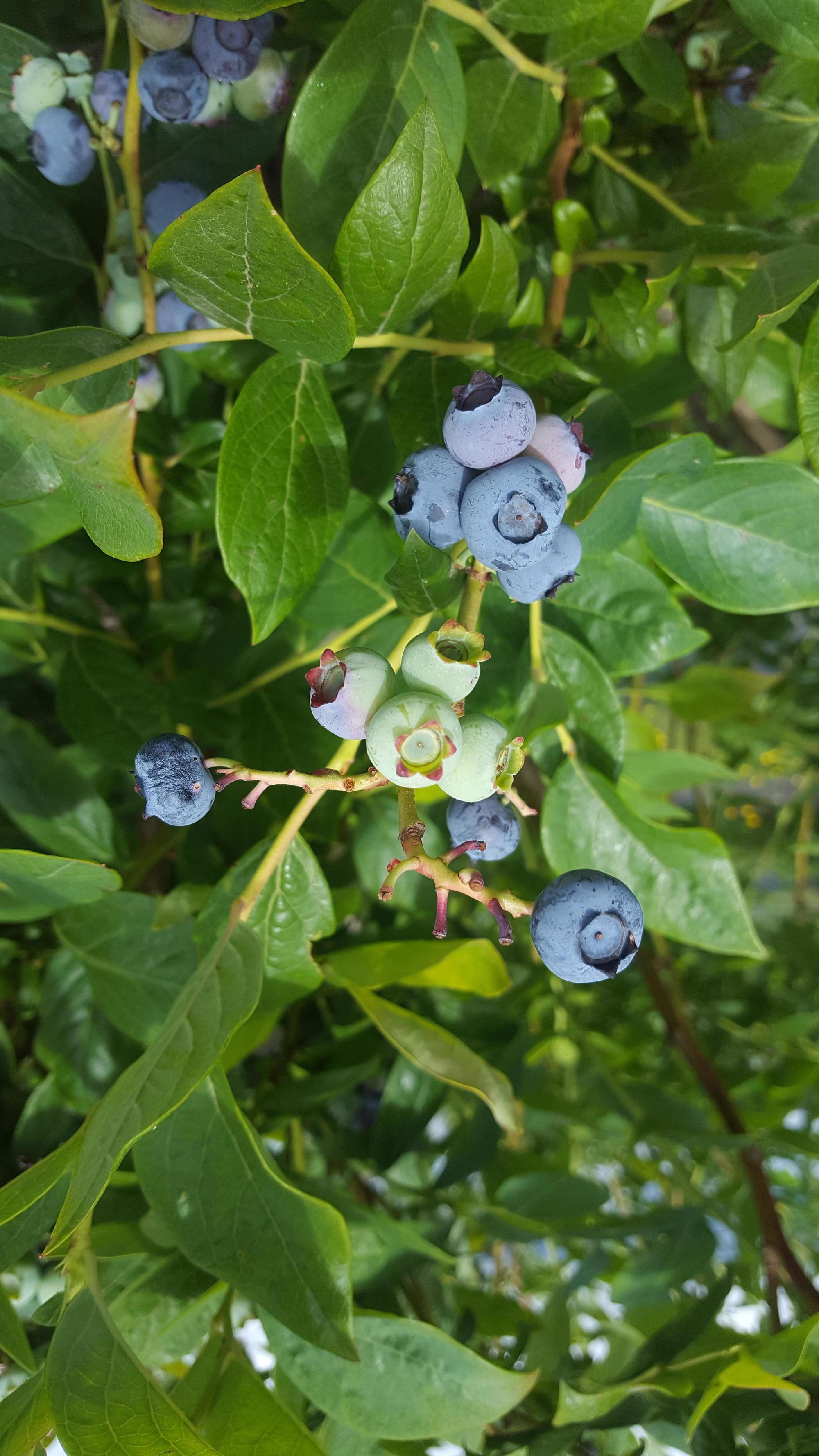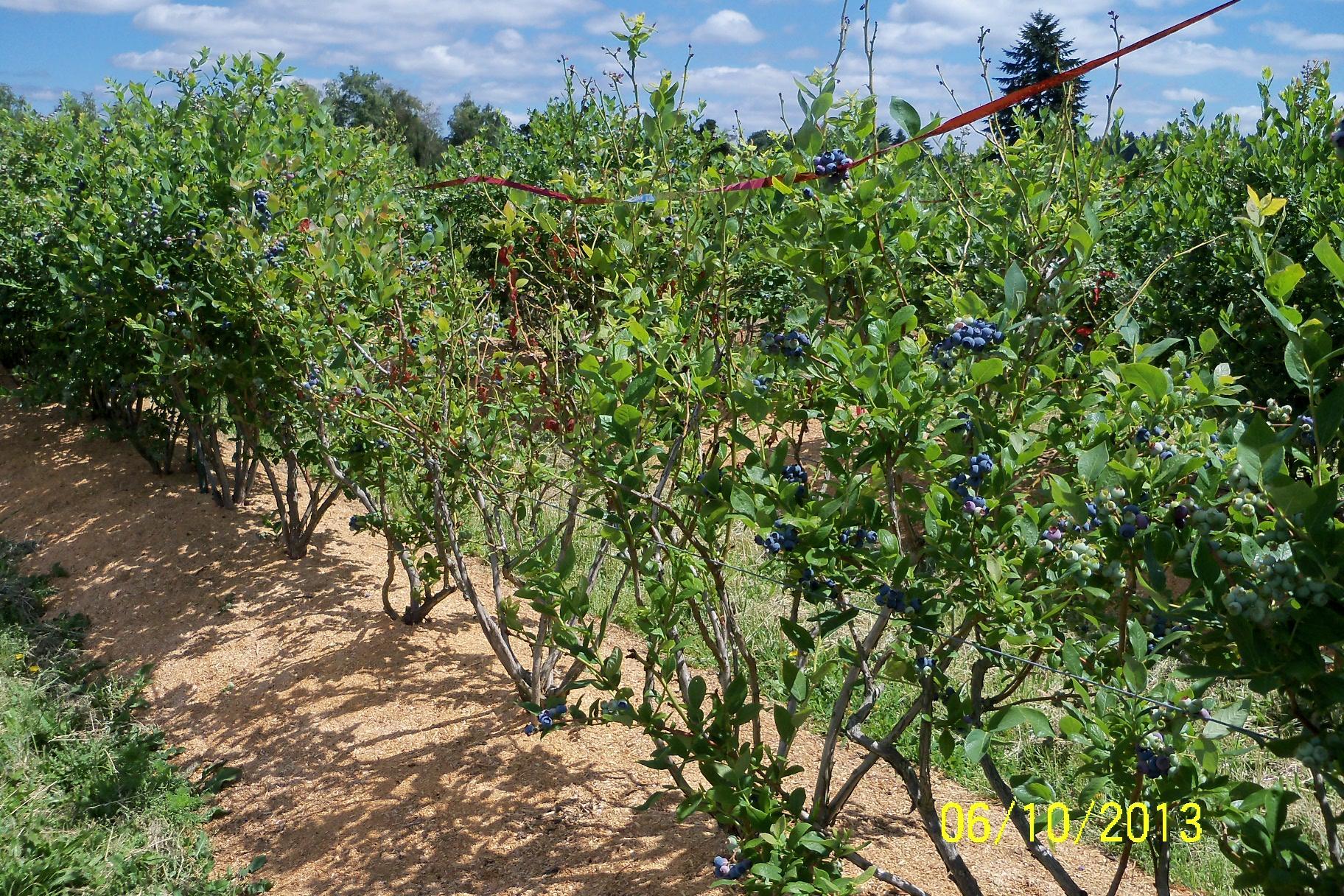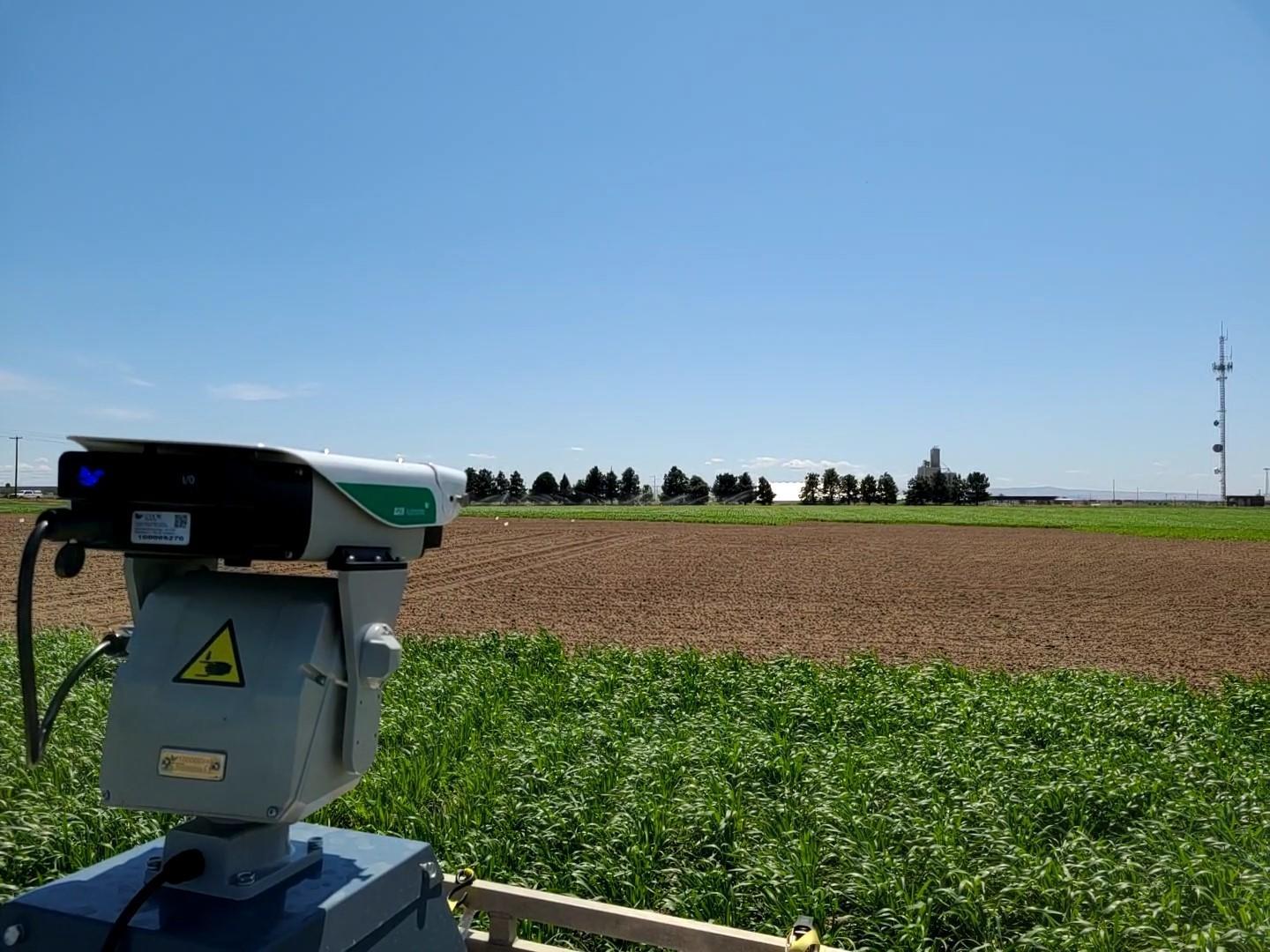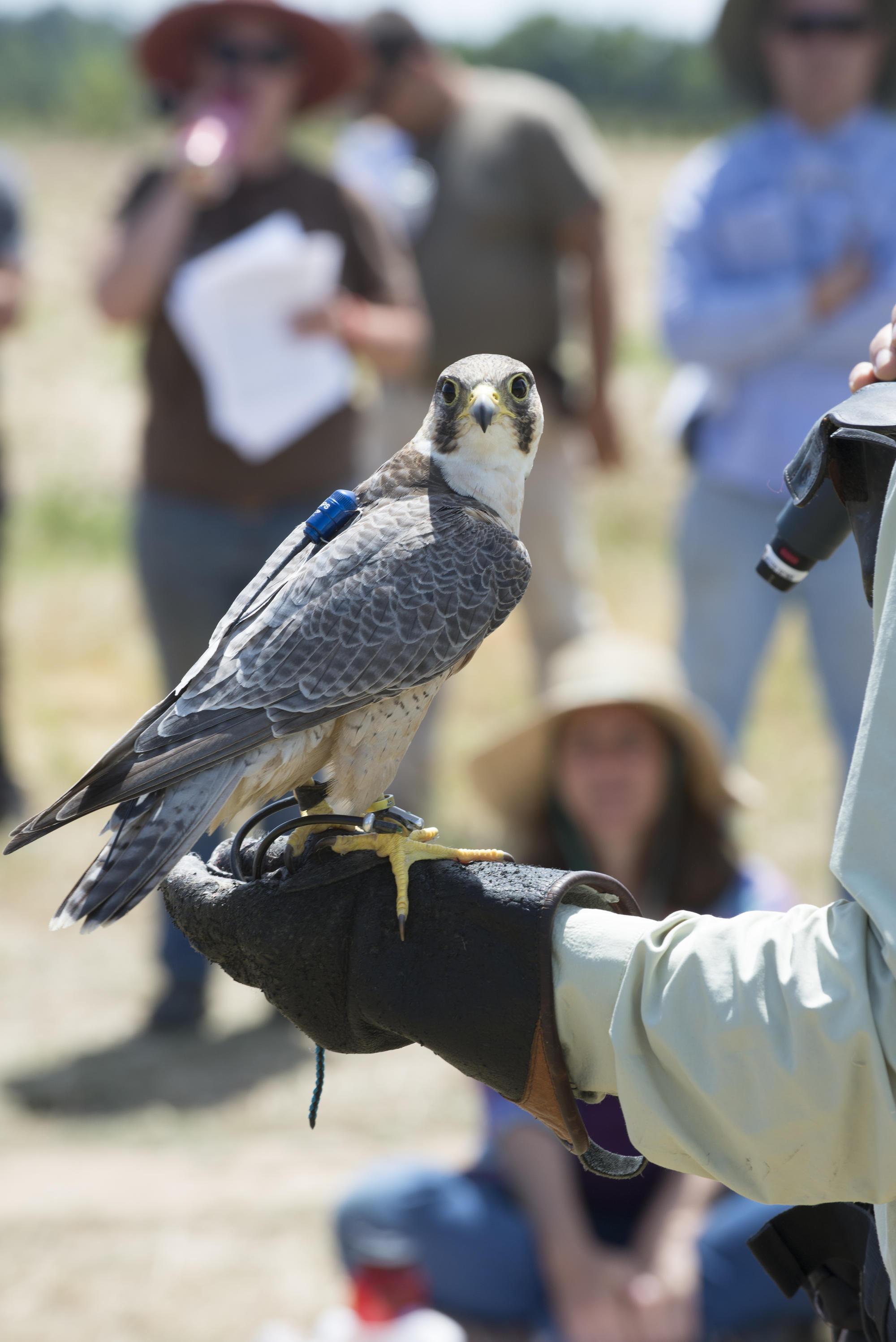Key points
- Bird predation can reduce marketable yields and increase production costs.
- Bird deterrent strategies must be designed with knowledge of:
- The species.
- Their feeding and habitat requirements.
- The habitat surrounding the crop.
- Deterrents function in multiple ways:
- They can physically prevent birds from reaching the crop.
- They can trigger fright responses as birds seek to avoid predation.
- They can present unpleasant tastes and sensations.
- Deterrents such as cannons and lasers must be managed to avoid habituation.
- Efficacy of some deterrent methods can vary by bird species.
- A variety of approaches increases chances for success.
Introduction
States along the Pacific Coast produce the majority of the nation’s berry and fruit supply. In 2018, Oregon supported 13,000 acres of cherries valued at $70 million, 13,500 acres of blueberry valued at $180 million and 33,283 acres of grapes valued at $209 million. While most of this effort is focused in the river valleys west of the Cascades, blueberry production is increasing in eastern Oregon and the Columbia Basin due to reduced disease pressure and more available space.
Production challenges differ across regions, but bird predation is a common threat wherever fruit is grown. Bird predation is a significant threat to marketable yields. Loss estimates are about 10% to 20% in blueberries, 5% to 30% in cherries, and 5% to 10% in grapes. However, some vineyard sites have reported up to 50% losses. In 2013, estimates of bird damage were $11.2 million for blueberries, $2.7 million for wine grapes, and $3.3 million for sweet cherries.
Early fruiting cultivars that ripen in late spring may be under greater pressure, leading to total crop loss for that year. Many variables drive year-to-year variation in food availability for birds and in movements of individual bird species across their geographic ranges. This complicates predicting predation pressure for agricultural fruit crops.
There are many avian deterrents on the market. Success with deterrents varies by site and bird species. In most cases, the best results come from a multipronged approach. In this publication, we will compare the strengths and weaknesses of widely used avian repellent technologies.
In Oregon, the birds responsible for the most crop damage include:
- American robins (Turdus migratorius)
- Red-winged blackbirds (Agelaius phoeniceus)
- European starlings (Sturnus vulgaris)
- Goose species, often Canada goose (Branta canadensis)
- Black-billed magpies (Pica hudsonia)
- American crows (Corvus brachyrhynchos)
- Ring-necked pheasants (Phasianus colchicus)
- Cedar waxwings (Bombycilla cedrorum)
- Eurasian collared-dove (Streptopelia decaocto)
A bird control management strategy must consider the most prevalent behaviors, as well as nearby bird habitat, such as wooded areas or wetlands. Bird predation on a fruit crop varies with nearby habitat quality. For example, cherry orchards close to woodlands received 7.7% crop damage compared to orchards close to wetlands (4.9%). By comparison, orchards close to rotational farmlands only suffered 3.4% crop damage.
Bird species differ in flock size, feeding habits, overall ecology and seasonal patterns. As a result, the damage they cause varies. Some birds eat the entire fruit while others only puncture the fruit. Robins tend to feed from the ground on berries growing lower on the bush. Starlings tend to land in the upper canopy and feed there.
Even partial bird damage can increase incidence of disease and insect pests, thus reducing fruit marketability. Partial damage also increases harvest costs as pickers must selectively avoid damaged berries. While fruit feeding is a direct loss, birds may also cause indirect losses by knocking fruit to the ground as they forage. Furthermore, bird feces may introduce pathogens into the food supply, a concern in crops like berries that are often eaten raw.
There is no single, simple solution to bird predation. A combination of methods should be used to reduce crop losses. A management plan must weigh the initial investment against the scale of crop loss. A cost-benefit analysis should consider the labor cost of implementing the control method and grading out bird-damaged product. In 2013, bird control benefits in Oregon were $2,055 per acre for blueberries, $3,900 per acre for wine grapes and $1,010 per acre for sweet cherries.
Legal considerations
Oregon’s Right to Farm Law allows growers to protect their crops with measures that fall within applicable laws and are performed in a reasonable manner. The Oregon Department of Agriculture encourages a Good Neighbor Policy when adopting any management strategy. The noise of many bird deterrent techniques can become a nuisance for neighbors. Open communication on the situation throughout its duration, and courtesy toward neighbors can reduce or avoid many issues. People living in agricultural areas are likely understanding of the grower’s need to protect their crops. Propane cannons and other hazing devices are unregulated and require no permit. But hazing fireworks do require a permit from the Oregon State Fire Marshal’s Office.
Be aware of state and federal bird protections:
- Starlings, house sparrows, Eurasian collared-doves and rock doves (pigeons) are the only birds not protected. These non-native and invasive species can be taken at personal discretion, provided pesticides are not used.
- Crows and magpies can be taken without a permit if they are coming from, going to or in the act of damaging agricultural crops.
- Upland game birds (such as pheasant, chukar, grouse and quail) and waterfowl (geese and ducks, for example), are subject to state and federal protections in accordance with season and license requirements. Contact your Oregon Department of Fish and Wildlife district biologist (503-947-6000 or 800-720-6339) if you are experiencing any issues with these birds.
- Raptors and most passerine, or perching, birds are migratory and subject to federal and international protections. Growers can work with the Animal Plant and Health Inspection Service (https://www.aphis.usda.gov/aphis/ourfocus/wildlifedamage/SA_Program_Overview) on economic damage situations. Inspection service biologists may be able to apply for variances and permits to reduce local populations of migratory bird species.
Bird deterrents by category
Visual
Many bird deterrents scare birds away with a perceived threat or by a visual disturbance. Birds are intelligent and may habituate to visual deterrents after repeated exposure. Visual deterrents are best combined with other tactics and rotated over time to maintain the “scare” value.
Commonly used decoys include natural predators such as hawks, owls and coyotes. Some decoys resemble dead birds; many birds interpret a dead member of their species as a sign of danger. Select a dead bird decoy closely resembling the principal pest species.
- Scarecrows are a proven visual deterrent. Inflatable tube air dancers improve on the scarecrow with active motion and noise.
- Other visual deterrent options include reflective and ultraviolet materials.
- Iridescent or mirror streamers reflect light and cause visual confusion.
- Some birds view areas of intense ultraviolet light as a threat. Ultraviolet paint can indicate a threat to some bird species.
- Strobe lights in the field provide a visual deterrent in some situations.
- Large balloons or kites decorated with reflective eyes scare birds away from a field. The research-based recommendation for best results is at least eight balloons per acre.
Lasers are the newest technology in bird deterrence. There is little data to support their effectiveness in crop protection, but anecdotal grower experience is promising. Options range from small but powerful hand-held units to fully automated units. Hand-held lasers require an active operator for use in the field to be effective, but an automated system, strategically positioned, provides a less labor-intensive option while still providing full field coverage.
Laser placements should avoid roadways or airways. Lasers should not be combined with reflective visual deterrents to prevent off-target beam reflections. Programmable automated systems can run random patterns across the field throughout the day and can be programmed to turn off at night. Although costly, lasers may increase marketable yields and decrease labor costs associated with other deterrent methods. Seasonal laser lease options reduce upfront costs and maintenance expenses.
Lasers require extreme caution to avoid damage to the eyesight of birds and humans alike. Many factors influence damage, especially duration of exposure, power of the laser, diameter of the beam, distance from the laser and the wavelength of the laser beam. Birds vary by species in their susceptibility to such damage. A laser safety training course may be required before purchasing or leasing a laser.
Auditory
Auditory deterrents are among the most cost-effective options in bird control. Options range from simple metal humming lines to explosive propane cannons, sonic “nets” and firecrackers. Humming lines are thought to vibrate at frequencies unpleasant to birds. Other products produce distress signals, alarm calls or other unpleasant sounds. Australian researchers found that species-specific alarm calls significantly reduced bird damage to apples.
These products can be stationary, or they may be connected to loudspeakers and moved around a field. Position speakers a few feet above the canopy for most effective sound dispersal. The effective coverage area of most devices ranges from 1 to 6 acres. Large operations may require multiple auditory deterrents placed throughout the crop.
Birds are among the most intelligent nonmammalian species. They quickly learn to ignore alarm calls that are presented in time and space patterns. For maximum effectiveness with these auditory strategies:
- Choose species-specific alarm calls.
- Randomize timing, duration and pitch of calls.
- Rotate the device around the area to be protected.
Propane cannons are popular auditory deterrents. The cannons produce a periodic high-decibel explosion that startles birds into flight. They are widely available and can be very effective. Cracker shells are shotgun shells with the lead shot replaced with pyrotechnic charges; their effect is similar to propane cannons. To reduce complaints, deploy these strategies only during the hours that birds are active, and inform surrounding neighbors and local law enforcement of your intent to use these devices. The Oregon Department of Agriculture document cited at the end of this publication offers practical tips on communicating with your neighbors about propane cannon use.
Chemical/Taste
Methyl anthranilate is the most popular chemical deterrent used to control bird feeding activity. It is a contact irritant that affects all bird species. Formal research has provided little evidence of its effectiveness, but it is widely used and commonly available. These sprays have a grape-like smell, are made from food-grade products, and are registered pesticides that can be applied by fogging or ground spraying equipment. Like any pesticide, methyl anthranilate must be used according to label directions. Multiple applications throughout the fruit ripening and harvest periods may be required.
Physical
Netting — absolute exclusion — is the most effective method to reduce bird damage to fruit and berry crops. However, it comes at a cost in infrastructure and labor.
- Cost of posts, wire and netting quickly add up over large acreages.
- Netting must be securely attached to support posts and to the ground to prevent bird entry.
- Netting requires regular upkeep and maintenance. Netting must be removed in winter to avoid damage to the netting or to support structures from snow or ice accumulation.
Netting is generally not a feasible option for large operations but some growers in eastern Washington produce hundreds of acres of blueberry under netting. Smaller operations and home gardeners can feasibly deploy this strategy.
Predatory birds are another physical deterrent option that can be achieved by creating habitat, or by employing trained bird handlers (falconers). Creating habitat to attract predatory birds can boost available habitat for these predatory species, while simultaneously helping to decrease pest pressure. In these situations, potential benefits include conservation of predatory bird species, reduced pesticide application and decreased crop loss.
- A registered falconer can patrol fields as the crop begins to ripen and through harvest. Though costly, this approach can be very effective with crops that ripen over a short window of time.
- Tall perches can be installed to attract hawks during the day and owls at night, encouraging them to hunt in the production area, especially if suitable habitat remains near the fields.
- Merlins, Cooper’s hawks and sharp-shinned hawks specialize in preying on small birds, and they hunt in-flight, not from perches. They nest in conifers or trees and shrubs in wooded and riparian areas, so their availability as helpers depends on the habitat near the growing area.
- Kestrels will use nest boxes and red-tailed hawks will use nest platforms. Kestrels are known to consume crop pests ranging from grasshoppers to starlings. Studies in Michigan cherry orchards have seen significant decreases in pest pressure after introducing kestrel boxes into orchards. It is important to confirm that bird boxes are not used by starlings or another pest species. See EC 1556, cited at the end of this publication, for directions for building bird boxes.
Barbed or spiked strips will prevent landing or roosting on specific surfaces, and electrified or nonelectrified screens can create small bird exclusion zones. Drones (unmanned aerial vehicles) can also protect crops from birds. Preliminary research in vineyards found that a single drone can protect up to 60 acres. Some companies offer this service.
Conclusions
Birds provide critical ecosystem, economic and cultural services, many of which interact to benefit growers, their families and communities. These contributions range from insect control, nutrient cycling, scavenging and seed dispersal and removal, to bird watching and wild game hunting. Despite peak-harvest fruit predation conflicts, birds provide vital predation on insects that would otherwise reduce crop yields. Birds provide humans with valuable benefits. For example, outside of damage season, waxwings feast on insects hiding on crop foliage.
High-value horticultural crops such as cherries and berries are an attraction that birds can hardly ignore. However, when we creatively and sustainably manage avian interactions with our crops at vital points in the growing season, we can enjoy the many benefits birds provide while fostering crop productivity. The most effective bird deterrent strategies balance cropping system needs, economics and environmental stewardship. Fruit growers can use the techniques described here to share a little less of their crop with the birds, maintain their marketable yields and implement a productive and environmentally friendly bird damage control program.
References
Anderson, A., C.A. Lindell, K.M. Moxcey, W.F. Siemer, G.M. Linz, P.D. Curtis, J.E. Carroll, C.L. Burrows, J.R. Boulanger, K.M.M. Steensma and S.A. Shwiff. 2013. Bird damage to select fruit crops: The cost of damage and the benefits of control in five states. Crop Protection, 52, 103–109.
Bird Protection for Blueberries and Other Fruit. 2012. University of Massachusetts Amherst Extension Agriculture and Landscape Program.
Brugger, K.E., P. Nol and C.I. Phillips. 1993. Sucrose repellency to European starlings: Will high-sucrose cultivars deter bird damage to fruit? Ecological Applications 2 (1993): 256-61. DOI: 10.2307/1941828.
Cates, D. and N. Allen. 2003. The Wildlife Garden: Build Nest Boxes for Wild Birds. EC 1556, Oregon State University Extension Service, Corvallis OR.
Courtney, R. and T.J. Mullinax. 2017. Sugar sours birds on eating valuable cherry crops: Sweet revenge for bird control. The Good Fruit Grower.
Douglas J. L. and C. MartÍnez del Rio. 2001. It takes guts (and more) to eat fruit: Lessons from avian nutritional ecology. The Auk, 118(4):819-831 DOI: 10.2307/1941828
Hazzard, R. 2013. Preventing Bird Damage. University of Massachusetts Amherst Extension Vegetable Program.
Oregon Department of Agriculture. 2020. Oregon’s Right to Farm Law.
Oregon Winegrowers Association. Standards for Bird Control in Vineyards.
Ribot, R. F. H., M.L. Berg, K.L. Buchanan and A.T.D. Bennett. 2011. Fruitful use of bioacoustic alarm stimuli as a deterrent for Crimson Rosellas ( Platycercus elegans ). Emu - Austral Ornithology, 111(4), 360–367.
Virgo, B. B. 1971. Bird damage to sweet cherries in the Niagara peninsula, Ontario. Canadian Journal of Plant Science, 51(5), 415–423.
Wang, Z., A.S. Griffin, A. Lucas and K.C. Wong, K. C. 2019. Psychological warfare in vineyard: Using drones and bird psychology to control bird damage to wine grapes. Crop Protection, 120, 163–170.
Whelan, C.J., C.H. Şekercioğlu and D.G. Wenny. 2015. Why birds mMatter: from economic ornithology to ecosystem services. Journal of Ornithology 156. Supplement: 227-38
Yeoman, B. March-April 2013. Follow the money. Audubon Magazine.
The Kool-Aid solution
Bird control is right on the shelf of your local grocery store. Grape flavored Kool-Aid contains methyl anthranilate, the same active ingredient found in the commercial bird deterrent sprays. Mix four packets of grape-flavored Kool-Aid with one gallon of water. Apply as a spray when fruits ripen enough to tempt birds. They may taste fruits a time or two after application. The use of this method may leave residual stains on fruit but should not affect taste once the fruit is washed. Multiple tactics, such auditory or visual measures, always lead to greater success.
Sugar water shows promise
Some growers in the Columbia Plateau have experimented with sugar water sprays to deter bird damage to small fruits. Birds cannot digest table sugar (sucrose); water absorption is reduced, and droppings are more liquid than usual.
We have little data about the impact of sugar sprays on ripening fruit or whether they increase fungal or insect pressure. There is anecdotal evidence that such sprays can be effective in many regions and against a variety of bird species. Research indicates that repeated exposure to sucrose and its impact to the gut of birds establishes an aversive response, and this aversion becomes more powerful with increased exposure to sucrose. To make 1 gallon of sucrose spray solution:
- Mix 2 quarts of water with 5 pounds of table sugar.
- Heat until the sugar dissolves.
- Add water to make 1 gallon.
Apply sugar spray as fruit begins to ripen and reapply after rain.
© 2020 Oregon State University.
Extension work is a cooperative program of Oregon State University, the U.S. Department of Agriculture, and Oregon counties. Oregon State University Extension Service offers educational programs, activities, and materials without discrimination on the basis of race, color, national origin, religion, sex, gender identity (including gender expression), sexual orientation, disability, age, marital status, familial/parental status, income derived from a public assistance program, political beliefs, genetic information, veteran’s status, reprisal or retaliation for prior civil rights activity. (Not all prohibited bases apply to all programs.) Oregon State University Extension Service is an AA/EOE/Veterans/Disabled.










